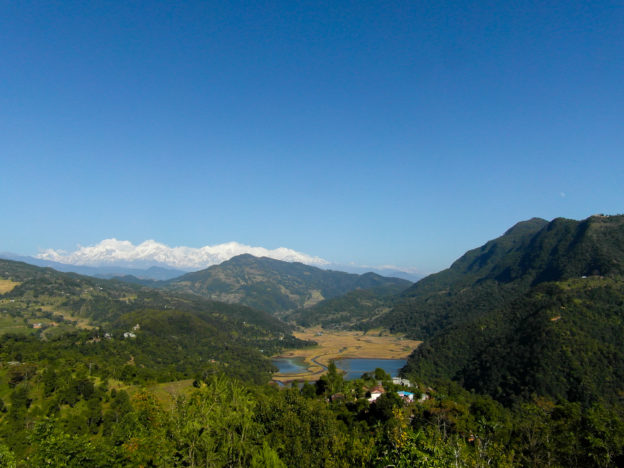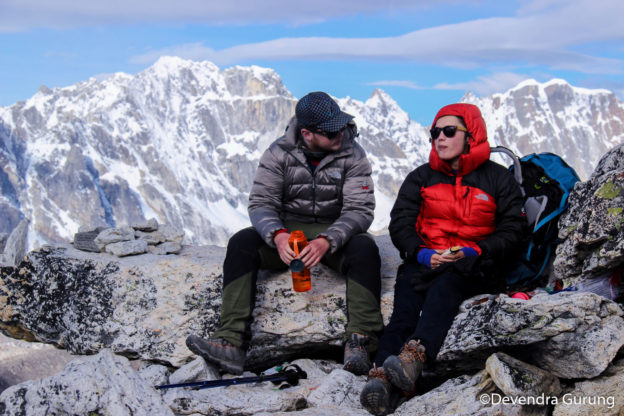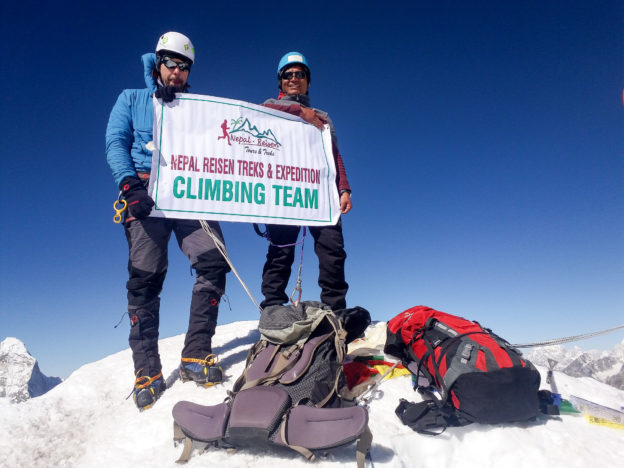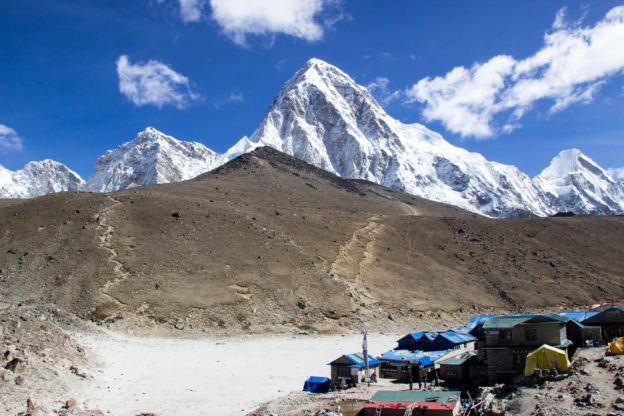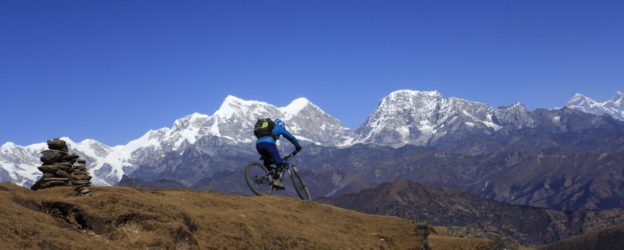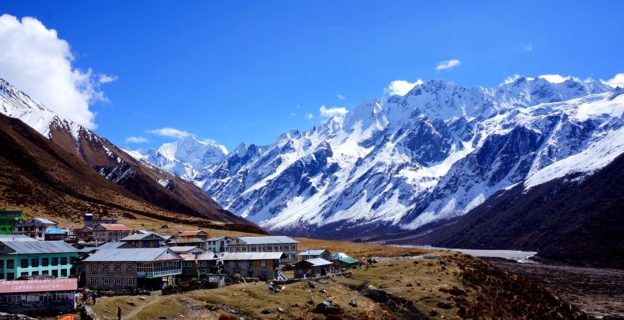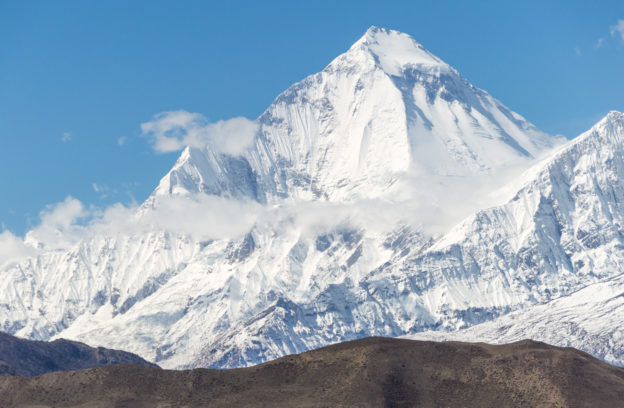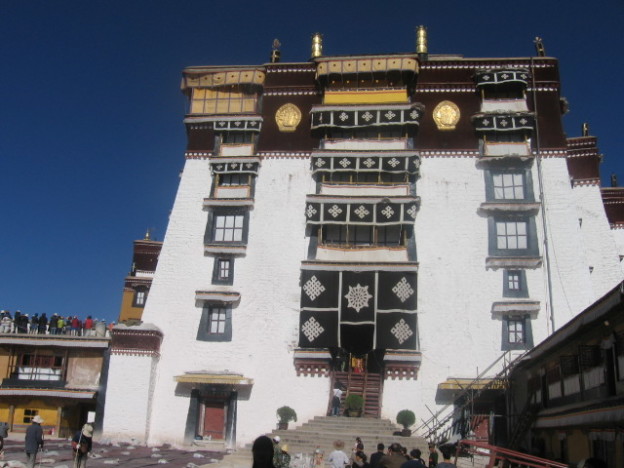Ladahk: Lying in the rain shadow area of the Great Himalayas, Ladakh is a cold desert area and the most sparsely populated land in the whole world with just two people per sq km. It is perhaps the only place where one can get frostbite and sunburn at the same time while sitting in the sun and stretching out one’s legs in the shaded area. The peculiar climatic conditions of the region feature the freezing winds and the burning sun at the same time. The snow-covered expanse of this rugged terrain attracts tourists with its fantastic and panoramic views. This white paradise is surrounded by some of the highest mountain ranges of Great Himalayas and Karakoram ranges that are young and mighty in geological terms. An independent kingdom of the 10th century, Ladakh was continuously pestered by the periodical attacks of the Kashmiri Muslims in the 16th century until it was finally annexed to their state in the mid 19th century. One can see distinct influences of the different visitors to the place in the Ladakhi culture. Culture of Ladakh Ladakhis are known for their cheerful disposition and most of their festivals fall in winters, which serve as an excuse for social and convivial gatherings. In summers, archery competitions and native version of polo are quite common and especially among the Buddhists.People of LadakhThe people of Ladakh bore much resemblance to Tibetans and Central Asians with their round faces, short stubby noses and small ‘chinki’ eyes with pronounced cheekbones. The people of the mountains, they have good stamina are accustomed to manual labor. However, they are considered to be soft and plain at heart.Leh CapitalSituated at an altitude of 3505 m above sea level, Leh is to the east of Jammu & Kashmir and is the capital of Ladakh. Zanskar River flows through it and breathtaking sparking white snowcapped peaks surround the valley of Leh. A blending of barren desert and well-irrigated farms, the ruined Tibetan style palace of Leh is the first to attract the attention of the tourists.
We like to organize our trip to Nepal as an individual private trip. With a German-speaking guide you will actively and individually discover unique mountain landscapes in the foothills of the Annapurna Massif, mixed with a highly interesting culture. Unforgettable experiences away from large streams of visitors make the journey a unique experience. Immerse yourself in the wonder world in the Himalayas – Nepal.
A journey for mountain, animal and culture lovers through one of the most beautiful countries in Asia. Nepal is a land of contrasts. At a distance of only 200 km, you will experience the snow-capped, highest mountains in the world as far as the subtropical lowland of the Terai on the Indian border.
The highlight of our trip is a 7-day Himalayan trekking tour in the foothills of the Annapurna Massive, with easy day hikes and a walking time of 4 – 6 hours daily. This unusual tour takes us to an area that gives us unique panoramas of the Himalayan mountains. Close enough to touch, we admire the mighty Giants of the Himalayas with the snow-covered Annapurna massif (8,091 m), the Dhaulagiri massif (8,167 m) and Machapuchare (6,993 m). The daily sections are unproblematic and mountaineering knowledge is not required. The hikes are to be mastered for every mountain lover with average condition. The luggage transport is taken over by porters, the participants carry only a light day baggage.
Another highlight of the trip is a visit to the Chitwan National Park in the lowlands of the Terai. It was founded in 1973 as a sanctuary for the endangered rhinos and in 1984 declared a national park by UNESCO. On the back of tame elephants, we roam through the jungle. The reserve is home to rhinos, deer, wild boars, crocodiles, alligators, river dolphins, tigers, leopards and more than 400 species of birds.
The ancient imperial cities of Kathmandu, Patan and Bhaktapur are Nepal’s cultural heritage. They are pearls of architecture. Between temples, pagodas, stupas, palaces, bazaars and markets we move in another world.
Everest Region: 3 passes have been the most famous trek for the trekkers. Renjo-La pass trek is one of the most best trekking route for both of them who have already been even Everest base camp and other who have not done. In Khumbu Chola and Renjola also known as Everest Circuit trek, this is one of the most adventurous treks in the khumbu Himalayas. It follows the route via high pass of Cho La at 5,330m into the base camp of Mt. Everest then Kongma La 5,535m to Chukkung. A unique trek that goes through Lukla, Namche bazaar and all the way to Gokyo, Chola Pass, Kalapatthar and Everest Base Camp.
During the trekking period we will explore the heart of the Sherpa homeland, visiting Namche Bazaar and Khumjung village before ascending the stunning Gokyo Valley. A string of glacial lakes is set like pearls in a beautiful high-altitude wilderness dominated by the great peaks of Cho Oyu and Gyanchungkang on the borders of Tibet. In the Chola Pass Trek we ascend Gokyo Ri, one of the finest vantage points for Mount Everest, Makalu and Lhotse. Crossing into the Khumbu Valley by way of the high and challenging Chola Pass, we then climb to the trekkers’ summit of Kalapathar, which affords more stunning views of Everest. Then it’s onto the Everest base Camp, scene of triumph and tragedy, where close-up views of the Khumbu Glacier can be.
Expert Asian designed this trek because the people who want to trek and climb the mountain to touch the sky. Located on top of the Chhukung glacier between Ama Dablam and Lhotse mountains, Island peak is the most sought after trekking destination because of its challenging geographical condition. Each year more than 300 groups attempt to scale the summit of island peak. This trek offers an excellent opportunity to climb a Himalayan Summit (6173m) together with an exhilarating Trek to the Everest Base Camp and Kala Pathar. The most difficult section is a mixed rock and ice wall at a slope of around 45 degrees leading to the narrow summit ridge.
The Island peak Expedition would be suitable for a climber visiting the Himalayas for the first time or keen hill walkers with previous mountaineering experience using crampons and ice axe. Island Peak is a more technical peak than some of the other trekking peaks in Nepal, it starts with an easy scramble along a rock ridge to a glacier and above there is a steep snow headwall leading to a classic summit ridge. The views from the top are superb including the south face of Lhotse and Ama Dablam.
Island Peak climbing with Everest Base Camp Trek is a fantastic experience in the Himalayas of Nepal. It is designed for energetic and physically fit trekkers with little or no experience in mountain expedition. Island Peak (6,189m/20,305ft) is one of the main climbing peaks in the Everest Region of Nepal with an impressive and highly glaciated West Face that rises from the Lhotse Glacier. Being one of the ‘trekking peaks’ with very little technical aspects, Island Peak is not a difficult undertaking for a beginner climber wishing to enter the incredible world of mountain climbing. Hundreds of climbers flock to Nepal every year to get a permit for Island Peak climbing. Our adventure also takes us into the heartland of the Khumbu Valley and Sherpa culture. Before scaling the peak, we also visit, possibly the most popular trekking destination in the world – Everest Base Camp (5,357m/17,575ft) and Kalapatthar – for the up close views of Mt. Everest and other high mountains.
This trek is an ideal way to explore the area around Pokhara for those short on time or relatively new to trekking, without missing out on the amazing views over the surrounding mountains or the experience of village life! Your trek starts in style with a gentle boat trip across Lake Phewa to take you to the start point, where a short climb will be rewarded with stunning views out across the Annapurnas, Machhapuchhare (Fishtail), Dhaulagiri and Manaslu, which will form the backdrop to much of the trek. The trail will take you up to the World Peace Pagoda, through the forest where you can see the flora and fauna of Nepal and past a number of villages where you can experience the daily lives of the local people. It takes you up to an elevation of 2500m on the summit of Panchase hill, from which (if you are willing to get up early enough!) you can see a stunning sunrise over the snowy Himalayan peaks. This trek is also a great extension to any of our tours of Kathmandu, Pokhara and Chitwan.
The Pikey Trek is a comfortable trekking route among the others treks with pikey peak (4,068m) being one of the tallest mountains of Solu. Name of the Pikey is taken from the two names of the Sherpa people. It is well known for its majestic sunrises, Himalayan range, Sherpa culture and their traditions. This trail through wind its way through Jiri, Chaulakharka and Ngaur to reach the Pikey Danda (Hill) area.
The Pikey Trek is renowned for its sunrise and sunset and magnificent views of the Himalayan range of Mt. Everest, Makalu, Kanchanjunga, Gauri Shankar, Lhotse Shar, Numbur, Khatang, Karyalung, Nuptse, Amadablam, Shishapangma, Thamserku and Mera Peak etc. The pikey Trek Base Camp trekking is one of the most popular trekking trails of the Everest region, probably one of the lower elevation view points to see the Mt Everest (8,848m). It is famous for because of having marvelous Himalayan scenery including the mountains range, the Rhododendron flower, Magnolia and wild orchids and the festival season in August that includes a cleansing ritual: thousand of devotees walk to the lake for the festival from village all around Solukhumbu.
This trek is approximately 12-13 days in length and start from Jiri ou 35 min flight straight to Phaplu can be also arranged.The main highlight of this trail is observing local monasteries; the Chewang monastery will be the best opportunity to explore spiritual paths. Also you could be able to observe different culture, languages, life style of the Tamang, Magar and Sherpa’s. Dramatic scenery of mountains, Main walls, Buddhist Stupas , Landscape, Himalayan floras and faunas, an ancient monasteries and splendid high altitude vegetation etc are the main attraction of this trail. While trekking passing through Pikey peak you will be able to experience sunrise views surrounded by mountain peaks like Kanchenjunga, Dhaulagiri and including Everest. Then we will walk down via unique landscape to Junbesi valley. The following day you trek to Thuptenchholing Monastery (Little Tibet) where you can observe traditional Tibetan medicinal therapy. You can also savor local food and drink; enjoy a Sherpa culture, where cultural show will be performed on your request. Then you will continue trek back to Junbesi and return Phaplu from where you can catch a flight for return back to Kathmandu.
Trip info:
This is one of the most beautiful treks that combine easy trekking with majestic scenery and mix of cultural treks in Nepal. this is also the best Trekking in Nepal.The trail starts from lowland villages and rice terraces deep into the Annapurna Himal. The principal peaks of the western portion of the great Annapurna Himal, including Hiunchuli, Annapurna South, Fang, Annapurna, Ganagapurna, Annapurna III and Machhapuchhare, are arranged almost precisely in a circle about 10 miles in diameter with a deep glacier-covered amphitheater at the center. From this glacier basin, known as the Annapurna Sanctuary, the Modi Khola knifes its way south in a narrow gorge fully 12,000 ft. deep. Further south, the gorge opens up into a wide and fertile valley, the domain of the Gurungs. The middle and upper portions of Modi Khola offer some of the best short trekking routes in Nepal, and the valley is located so that these treks can be easily combined with treks into the Kali Gandaki region to the west.
In spite of the great heights of the surrounding peaks and ice walls, the valley floor between 12,000 and 14,000 ft. can provide comfortable camping spots in good weather.
it is also Familiy Trekking.
The Langtang Valley is located only 19 miles north of Kathmandu, close to the border of Tibet. The valley is dominated by Langtang Lirung [7246m], the highest peak in the area. This is a superb introduction to trekking in Nepal among some of the most beautiful scenery in the whole country.
This Langtang trek towards the base of Langtang Himal, north of Kathmandu valley, offers the shortest approach to snowy mountains from Kathmandu. The Langtang trek starts from Syabru Besi after a 9 hrs drive from Kathmandu. Following a trail upstream Bhote Kosi river through ethnic Tamang villages, lush green forests and the wide spread Kyangin valley surrounded by snowy peaks from all fours sides, takes you up to Kyangin at 3800 meter, where you get an opportunity to ascend Kyangjin Ri [4350m.], from where the 360 degree mountain views are truly panoramic. After an ascent of Kyangjin Ri, we retrace our route back down the valley to Syabru Besi and then drive back to Kathmandu.
Due to gradual ascent along the river valley this Langtang trek is not considered strenuous, but yet, it remains challenging as it reaches an altitude of 3800 meter at Kyangjin. The Langtang trek can be done any time of the year except during monsoons [July & August].
Dhaulagiri is one of the most popular 8000m Peaks for climbing in the Himalayas. The seventh highest mountain in the world, Dhaulagiri lies north – west of Pokhara culminating to its highest point at the eastern end. Dhaulagiri is almost unique in the world in terms of its rise above local terrain where it rises to 7000m over the Kali Gandaki gorge to the south east in about 30 km of aerial distance. In fact, Kali Gandaki is dramatic as two eight thousand Annapurna I and Dhaulagiri both stand near the river facing each other over a deep valley.
Daulagiri was first discovered in 1808, and it was thought to be the highest mountain in the world for westerners. It was assumed the highest peak for 30 years before its place was taken by Kanchenjunga. Dhaulagiri literally means ‘white mountain’ which justifies a magnificent peak rising as a giant shoulder of shining ice and snow.
Lhasa, most popularly known as ‘Sunlight City’, is regarded as the heart and soul of Tibet. It is the most sought after tourist destination in Tibet. Two blissful days are packaged in your trip for exploring the charismatic wonders of Lhasa. Visits to the white and ochre fortress of Potala Palace and Jokhang temple can be a spiritually rejuvenating experience. Potala Palace, a UNESCO world heritage, features an overwhelming array of intricate murals, temples, stupas, tombs of eight past Dalai Lamas, exquisite Tibetan mandalas and other relics of Tibetan history. Jokhang temple lying 2 km to the east is another Tibetan religious site. In the Buddhist monasteries of Sera and Drepung will get to see the monks and get an insight into their lifestyle.
Exploring Barkhor markets gives you an insightful glimpse into Tibetan culture. As you wander around the markets, you witness Tibetan art, culture, custom and tradition. With so much to see and explore in Lhasa, this will truly be an unforgettable experience.


